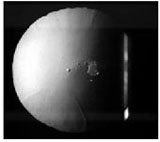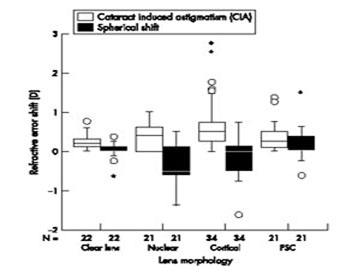
Refractive error changes in cortical, nuclear and posterior subcapsular cataracts
Aims: To determine the effect of the three main morphological types of cataract on refractive error.
Methods: Data were prospectively collected from 77 subjects (age 67 (SD 8) years) with one morphological type of cataract. 34 had cortical, 21 had nuclear, and 21 had posterior subcapsular cataract. 22 subjects with clear lenses (60 (7) years) were recruited as controls. The spherical equivalent and astigmatic vector change between spectacle correction and optimal refraction were calculated.
Results: The cortical cataract group showed a significant astigmatic change of 0.71 (0.67) D (mean (1 SD)) compared to the control group (0.24 (0.20) D), with 24% outside the 95% confidence limit (0.63 D). The nuclear cataract group showed a significant myopic shift of -0.38 (0.60) D compared to the control group (+0.02 (0.21) D), with 52% beyond the minus 95% confidence limit (-0.39 D).
Conclusions: A quarter of subjects with cortical cataract showed larger changes in astigmatism than subjects with clear lenses. This is probably because of the localised refractive index changes along cortical spoke opacities within the pupillary area. The well known myopic shift of nuclear cataract was also demonstrated.

Figure 1 Spherical refractive error shift and cataract induced astigmatism
for each lens morphology.
Br J Ophthalmol 2003;87:964-967
K Pesudovs, D B Elliott
Department of Optometry, University of Bradford, Bradford, BD7 1DP, UK
Accepted for publication: 20 December 2002
![]() Refractive Error as PDF (182 Kb)
Refractive Error as PDF (182 Kb)
![]()
Index of Papers
[ Welcome ][ Publications ]